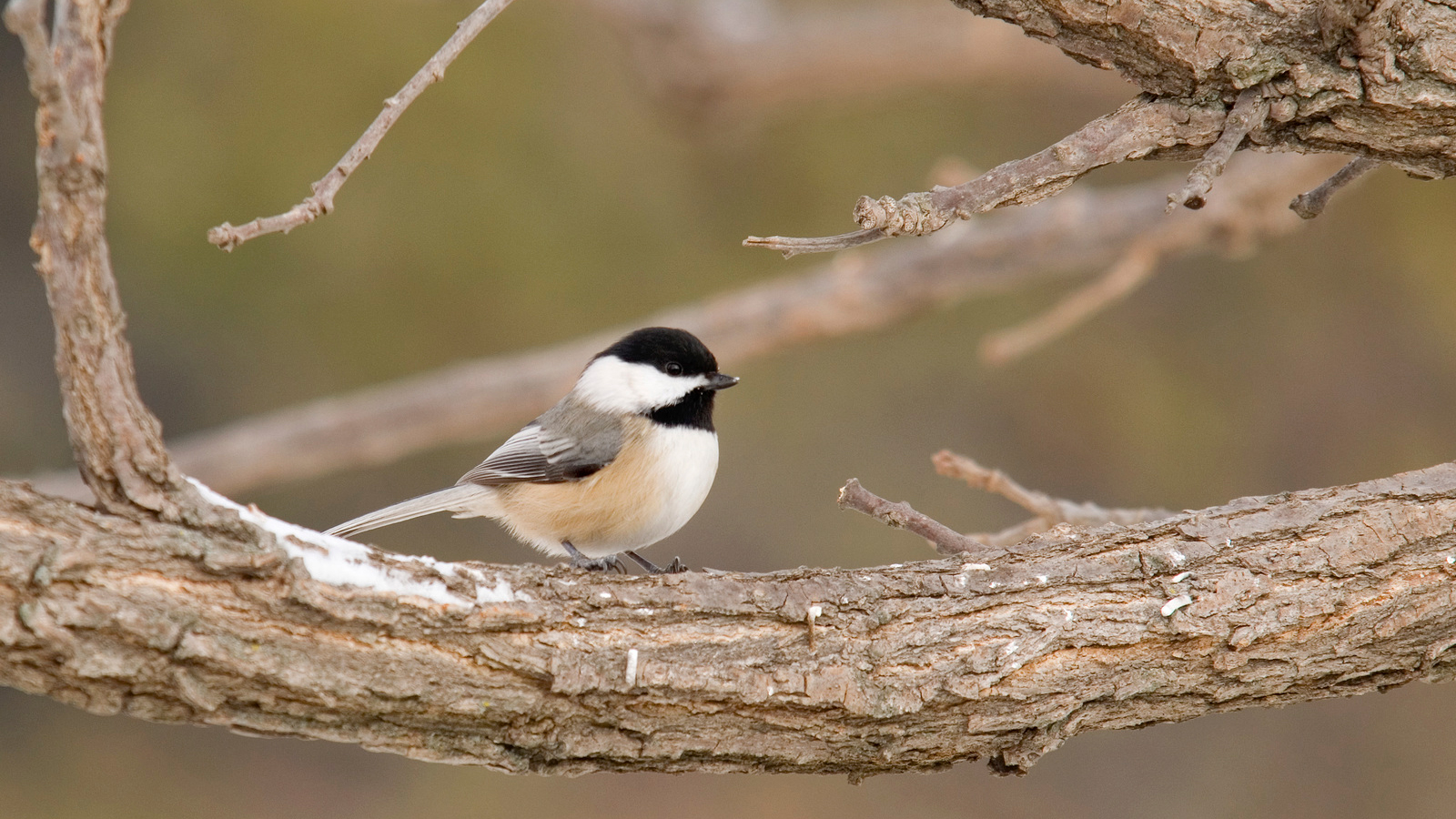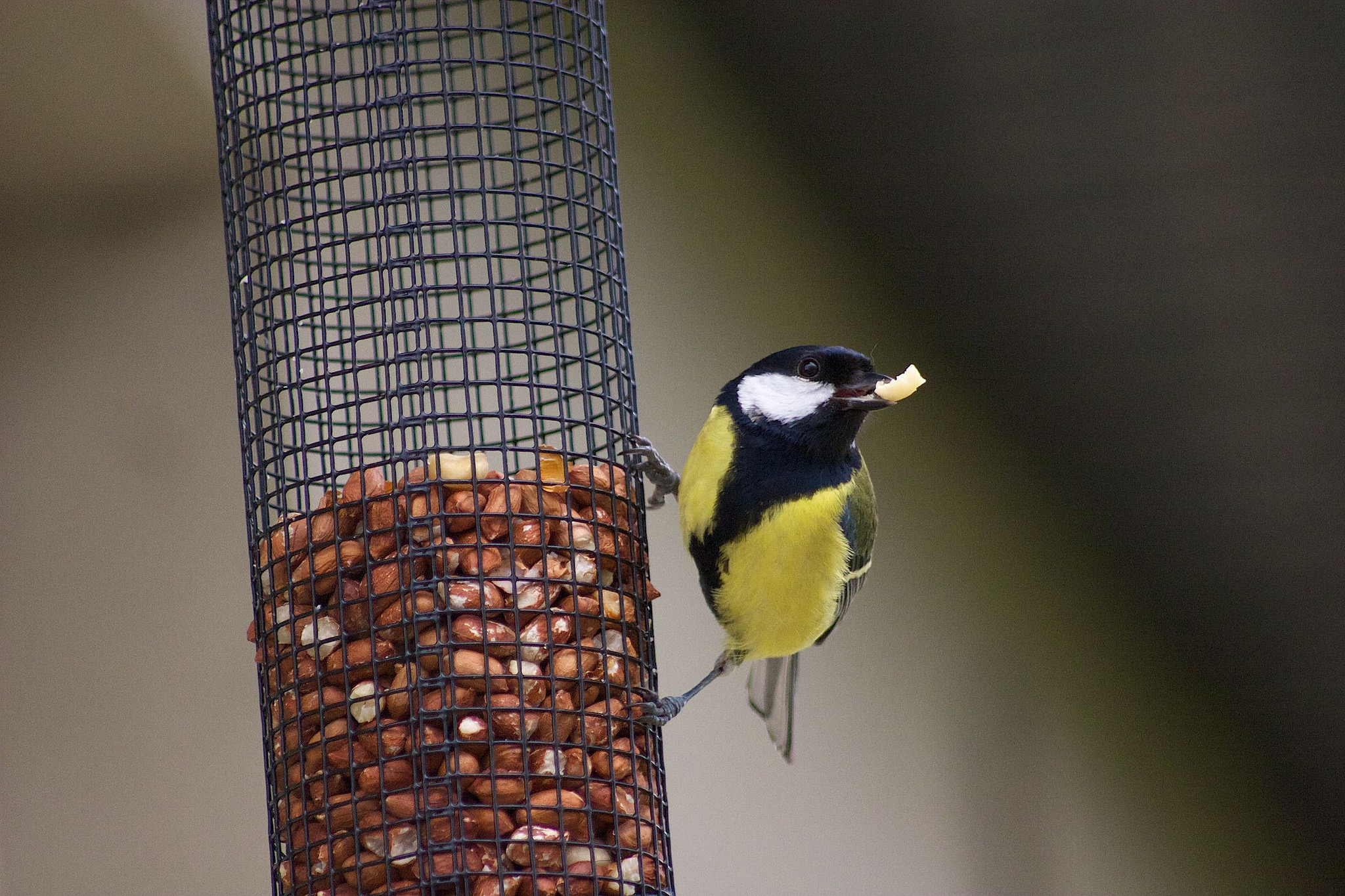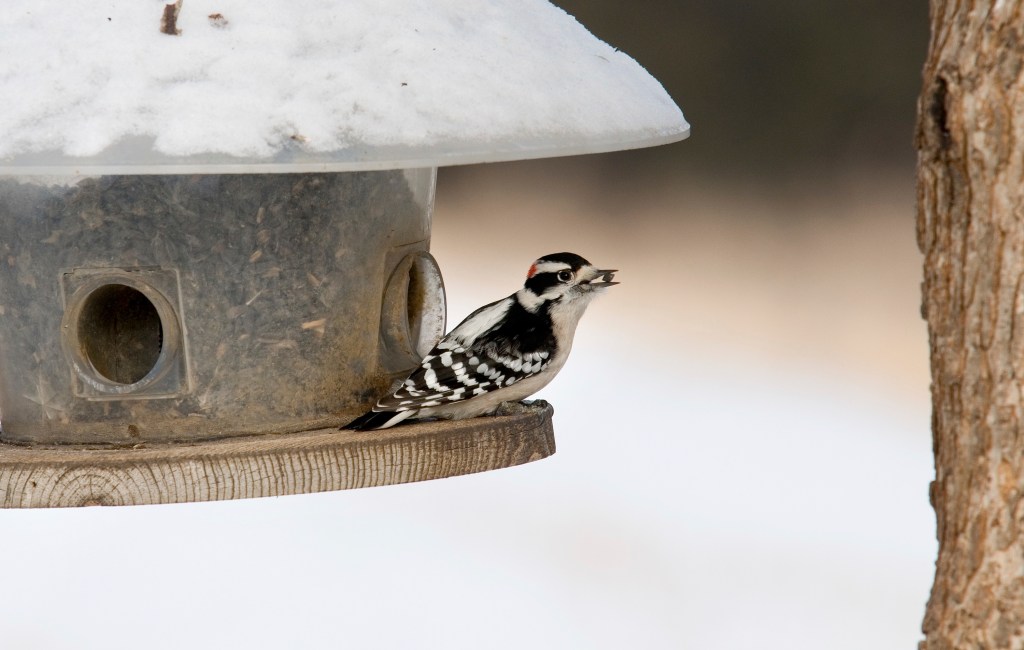Winter bird feeding is one of the most popular ways for people to interact with nature, and most do it to help birds get through these tough months. But what does this really mean for conservation? Does feeding help or hurt birds?
More than 40 percent of U.S. households feed their backyard birds, and in the United Kingdom, the rate is as high as 75 percent.
Despite the widespread popularity of bird feeding, scientists are still building a basic understanding of its impacts.
As we might guess, a number of studies show generally positive impacts of bird feeding. For example, the overwinter survival of birds is enhanced by bird feeding.
This is especially true during the coldest times, when some hungry birds might otherwise lose the battle with the elements1.
A study conducted during winter in Wisconsin showed that black-capped chickadees with access to bird seed had a much higher overwinter survival rate (69 percent) as compared to those without access to human-provided seed (37 percent survival).
Furthermore, some studies have shown that birds making it through the winter in better physical condition see those benefits carry over into the nesting season.
Bird feeding produces significantly earlier egg laying dates, larger clutches of eggs, higher chick weights and higher overall breeding success across a wide range of bird species2,6.

The greatest impact of feeding is seen when birds are most challenged, such as after particularly harsh winters, or when birds are young and inexperienced, or when they are living in low-quality habitats2. Feeding can promote the survival and reproduction of the not-quite-fittest.
But in contrast to these straightforward results – showing that bird feeding makes for better-off birds – a few studies indicate that, at least in some situations, there may be unintended consequences of bird feeding.
A European relative of the black-capped chickadee, the blue tit, was studied in the United Kingdom to examine the impact of bird feeding on nesting success.
One research group3,4 found that birds fed during winter subsequently laid a smaller number of eggs that had lower hatching success and ultimately fledged fewer young than birds that weren’t fed at all. The offspring that did fledge weighed less and had a lower survival rate than the young of unfed birds.
An additional U.K. study of the blue tit and another chickadee-like species, the great tit, had similar findings.
Both species, when they had access to bird food, laid fewer eggs, had lower hatching success, and ultimately had fewer chicks fledged.

Note, however, that these are just two studies demonstrating a negative effect of bird feeding – among a majority that show positive effects.
Nonetheless, the striking findings of lower reproductive success in supplementally fed birds need some explanation. Unfortunately, it was beyond the scope of these U.K. studies to definitively explain how bird feeding resulted in lower reproductive success, but the authors offer several possible hypotheses.
One possibility the authors suggest is that the bird feeding provided an irresistible diet that was unbalanced – too high in fat to produce high-quality eggs. More protein, micronutrients, and antioxidants than are provided by bird seed may be needed to produce high-quality eggs.
Another possibility is that bird feeding allowed individuals with a lower reproductive capacity which ordinarily would not survive the winter the chance to nest.
A final possibility is that the feeders were placed in poor quality nesting habitat – leading the birds to choose these suboptimal sites as nesting areas in the spring.
More research needs to be done across a wider geographic area and on more species to understand not only the impacts of bird feeding on reproductive success, but also on other factors such as disease transmission, species range expansion, and population trajectories.
Citizen scientists can help by participating in initiatives like Project FeederWatch that ask people with bird feeders to share their observations. What you see in your own backyard can contribute to the efforts to answer these questions.




Hold on here a second, once again, we are being mislead by what probably will turn out to be a data anomaly. Two studies against several hundred to the contrary is a reason to do more study, not make dire predictions. We capture and band our birds to do a SCIENTIFIC study of whether or not feeding affects numbers and without a doubt, it makes more birds, period. Diversity comes from providing the needs to as many of your birds as possible, expensive, maybe, worth it, no doubt. Because people have invaded their environment, the balance is tipped against them. Oh and by the way, a bit of layena or other chicken food supplement will add calcium to their diet and make stronger eggs, yes, it has been studied. Common sense, which seems to disappear every time this discussion happens, would dictate there is a way to overcome the few problems with feeding versus the benefits. For me it is obvious, I feed my birds!
here in upstate NY right now we have 15 inches of snow in this harsh winter. I feed all types of birds with as all natural (i.e. no blocks made with beef byproducts for instance and you can make your own DIY healthier anyway) with all types of feeders and keep a natural landscape with several bird house. I have water as well and see all kinds of birds. some are bullies in nature and you can see it up close. but overall I think it is a positive impact. cats k)(*ll FAR more birds every day and sometimes you see the gr98usome results but you can only put up so many fences to keep them out anyway and there are NO laws to force people to be responsible owners…so I think positive impact FAR outweight neg. since there are so many other variable (bats for instance here are about wiped out right now from white nose fungus and used to love those and insects now are out of control as well as all kinds of invasive species (here we have asian longhorned ashborer and jap beetle whose grubs are a HUGE nuisance (but STILL keep all 100% garden and lawns since other animals like those as well). milky spore and nematodes largey control them. there are SO many factors we are, as humankind, influencing, so in overall scheme of things, I will keep a variety of birdhouses and feeders and I think it is a net positive (without doing a stat signicant replicable scientific study) and US politicians hate science anyway! so it would be ignored anyway.
It seems to me that relying on bird feeders to support winter birds tends to favor some bird species over others and invariably leads to large numbers of “undesirable” birds hogging the feeders (House Sparrows, House Finches, Starlings, grackles, etc.). I much prefer to focus on making my yard a source of food, not only by planting native fruit-bearing and seed-bearing plants, but also and perhaps more importantly, not keeping a “clean and tidy” yard. Leaf litter, fallen branches, and seed heads from summer flowers provide a natural source of food and provide nooks and crannies for overwintering moths, butterflies, and other insects. When I see flocks of birds feeding in my yard and avoiding my neighbors’ yards of manicured lawns and exotic plants, I know I’m on the right track. If more people focused on backyard feeding through providing habitat, I can’t help thinking that would benefit birds (and beneficial insects) more.
I disagree. Compare the number of species that inhabit your area, the birders have counted them for you already. Provide the necessary food and feeders for them and no one gets left out. I have not seen an increase in the more aggressive birds versus the more timid ones, just separate them. They don’t eat the same thing and that is where you can control to some degree the variety of species. If some idiots hadn’t have decided to introduce every species mentioned by Shakespeare, you wouldn’t have near as many of those species but the damage is done and now we live with the starlings. Try moving the feeders apart and smaller stations make for less mass bird mobs swapping parasites and Lord knows what. Don’t forget the ground feeders as well, they have to eat too and don’t like getting too far from their cover. It just takes some common sense.
Every 2 or 3 weeks a Cooper’s or Sharp-shinned Hawk takes advantage of the chance to feed on birds gathered at my feeders. The former is becoming more common; the latter, less so. I wonder why they do not come more often.
Because they don’t just eat at your house! I have a Coopers Hawk that comes by a couple times a month to chase the birds through the bushes. Sometimes he gets one, most times he bashes around in the bushes until he is tired and leaves. If I find dove feathers, he has eaten well. He picks the bird clean and then takes them home so not to mark his nest. The studies indicate they run home feeders like a trout line, moving from one to another to keep the birds unwary. That behaviour is a direct result of home bird feeders, but who doesn’t like raptors? They have to eat also and in the grand scheme of things, their health is an indicator of your health. You are lucky to have one to watch, their antics are priceless.
Seems like the balance is for feeding in the MN/WI border area. As always, organic is better. The blue tit studies in the much warmer UK, are not directly applied here. Each year more birds at the feeder from chickadees to pileateds. But keep the information coming.
A fourth possibility for the negative effect on breeding seen in the tits is that reproduction may be affected by population. That is, when the spring population is low, the birds are biologically programmed to a higher reproductive rate to replace winter-kill, whereas when more birds survive there is less need for replacements, and reproductive rates drop.
I have often wondered whether feeding birds detracts from their finding moth eggs, pupa etc of insects we want to keep in check. That would be their normal food but bird feeders are easier and birds are not stupid. Does it have any effect on insect populations? Also of course infections and disease can be spread more easily. The” bringing into the fold” of new bird enthusiasts sometimes outweighs these negatives as they are more likely then to regard protecting the ecosystem as important. It is a delicate balance. We do not want to harm the birds so more research is needed. thanks for engaging in the conversation.
I must admit that I feed birds primarily to watch them, so I compromise by putting a small amount of seed (1/2 cup or so) in the feeder every day. It’s not enough to make them dependent on my feeder, but enough to keep them coming back to check for seed.
Birds in nature don’t eat beef fat, high in hormones. Millet is a low-quality seed. I avoid suet with beef fat and I don’t give them suet with millet in it. Yes, the suet I give them is more expensive, but I figure it’s better for them. Cheap bird food made with crappy ingredients may be the problem.
I live in a midwestern rural area with lots of hardwoods, undergrowth, and open fields so suspect my sunflower seed and suet is more supplemental than essential. I get a wide variety of birds native to the area with few passing through. Been winter feeding birds for 30+ years but the discussion above has about convinced me to stop. When the this bag of seed and suet cakes are gone (160# seed and two dozen suet cakes so far this season),think I’m done. No more participation in the GBBC either. They’ll be out in the woods or at the next closest feeder and I won’t see them to count. If I’m doing more harm than good, what’s the point?
These are only two studies, with small sample size. More studies are needed before any conclusions can be drawn.
One of the cited studies suggests that it is the quality of the provisioned food matters. When fat sources were supplemented with vitamin E, the negative effects on egg quality were mitigated. Even where this supplement was absent, however, overall population of the Blue Tit species (studied) increased through feeding.
Here’s a quote from one of the cited sources:
“Our study is the first to report deleterious effects of provisioning that were carried over from one season to the next. We emphasize, however, that our study focussed on egg phenotypes; it will be important to see how these effects translate into fitness consequences. The mechanism by which these negative effects were generated is of key importance; the provision of energy-rich fat supplements in winter had negative consequences for female egg investment several weeks after provisioning stopped. Yet at the population level, this was mitigated by the provision of fat together with vitamin E. This is the first direct evidence that the specific nutritional composition of provisioned foods may determine whether carry-over effects on breeding performance are positive or negative at the population level. Therefore, where provisioning is practiced as a conservation tool, careful consideration should be given to the nutritional composition of foods. Whether winter provisioning of garden bird species is considered to be beneficial or deleterious may depend on whether effects are interpreted at the level of individuals or populations. Provisioning may lead to a reduction in average levels of egg quality at the population level. However, if provisioning enables certain low-quality individuals to breed, when they might otherwise have died or survived only as non-breeders, this would clearly enhance their lifetime reproductive success and may in fact boost the overall population size. It is evident that further work at the level of individuals is needed to understand how winter feeding may be used to benefit wild bird populations in the future.”
I’m curious, has anyone noticed if feeding birds all winter has changed some migrating birds to non migrating birds?
The disturbance of “survival of the fittest” appears to be one consequence of feeding birds during the Winter Months. I agree with comment that siding survival of less healthy birds shall produce statistics affected by inclusion of information skewed by their presence. I do not see this probable impact as absolutely a negative. However, I do agree that feeding stations locations need to be assessed as to optimizing positive impacts; versus, causing relatively unattractive breeding areas being enhanced